.jpg)
7 Best Connected Worker Platforms for 2025


Frontline teams are the engine of operational success, yet they remain largely excluded from digital transformation strategies. While office staff benefit from a full suite of SaaS solutions, deskless workers are still navigating outdated tools, fragmented communication channels, and manual workflows, a gap that directly impacts productivity, compliance, and employee retention.
As labor markets tighten and customer expectations rise, organizations are shifting focus to a more strategic asset: the connected worker. Connected worker platforms have matured into scalable, mobile-enabled systems that integrate AI, SMS-native messaging, safety protocols, and real-time task management, all explicitly designed for deskless environments.
In this blog, we'll explore the 7 best connected worker platforms of 2025, comparing key features, industry fit, deployment speed, and adoption advantages. Whether in construction, logistics, healthcare, or manufacturing, this guide will help you identify the platform that aligns with your operational goals, workforce needs, and digital roadmap.
What is a Connected Worker Platform?
A connected worker platform serves as a unified digital hub for non-desk teams. These systems digitize manual tasks, streamline communication channels, and collect actionable data from field operations. The platform bridges the gap between frontline workers and management teams.
Modern connected worker platforms share several essential features that distinguish them from basic communication tools:
- Mobile and SMS Access: Workers can connect using smartphones, tablets, or basic phones through text messaging. This flexibility ensures every team member stays connected regardless of their device preferences.
- Real-time Alerts: Critical information reaches workers instantly through push notifications, SMS, or voice calls. Emergency alerts, schedule changes, and safety updates arrive without delay.
- Workflow Automation: Routine processes like shift confirmations, task assignments, and status updates happen automatically. This reduces administrative burden and prevents communication gaps.
- Safety and SOP Tracking: Digital checklists, protocols, and standard operating procedures keep teams compliant. Workers can access procedures instantly and confirm completion in real-time.
- System Integration: The platform connects with existing HRMS, ERP, and operational systems. Data flows seamlessly between platforms without manual data entry.
These features work together to create a comprehensive solution that addresses frontline teams' unique challenges today.
7 Best Connected Worker Platforms In 2025
In 2025, connected worker platforms have become essential for empowering frontline teams with real-time communication, automation, and safety tools. From SMS-native solutions to AI-driven systems, these top platforms offer unique strengths tailored to the diverse needs of non-desk workers across industries.
1. Udext
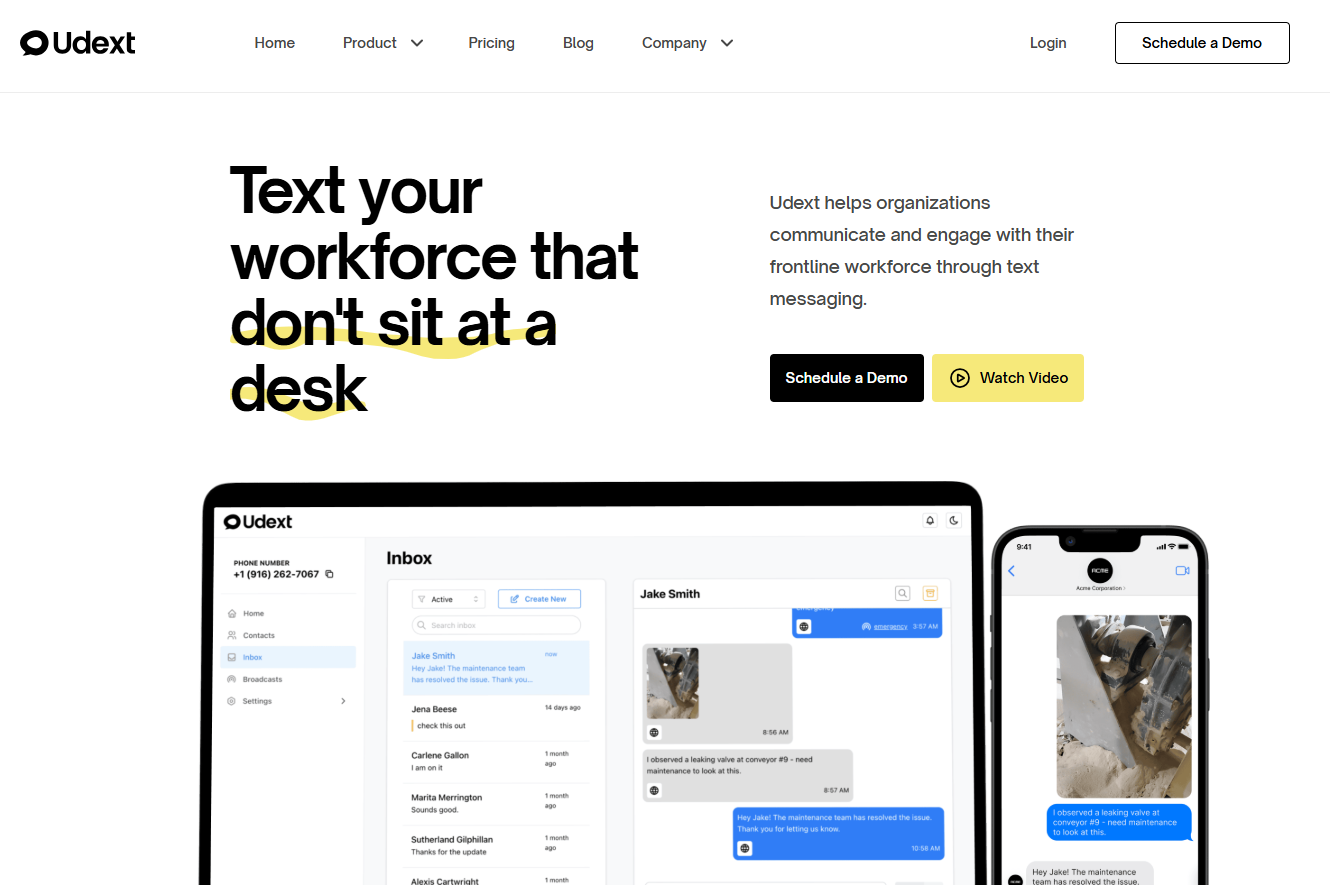
Type: SMS-native communication platform
Best for: Construction, healthcare, logistics, and high-turnover industries
Udext is a purpose-built SMS-native platform that transforms frontline communication by making it fast, simple, and universally accessible. Designed for deskless teams, Udext eliminates the need for apps, logins, or training, delivering instant, two-way messaging directly via SMS.
The platform streamlines critical communication across industries like construction, healthcare, logistics, and manufacturing, from shift updates and safety alerts to employee feedback and surveys. With powerful automation, multilingual support, and seamless HRIS integration, Udext ensures high engagement and compliance even in high-turnover or low-tech environments, bridging communication gaps and boosting frontline productivity from day one.
Key Features:
- App-free communication using two-way SMS messaging
- Automated shift updates and confirmation systems
- Multilingual survey capabilities for diverse workforces
- Safety alert distribution and acknowledgment tracking
- Direct integration with 200+ HRIS systems
Strengths:
- Achieves ultra-high adoption rates across all worker demographics
- Delivers the fastest rollout timeline in the industry
- Requires zero learning curve for immediate productivity
- Perfect solution for high-turnover teams and seasonal workers
Ideal Use Case: Teams requiring immediate, reliable communication without technology barriers or extensive training periods.
2. Tulip
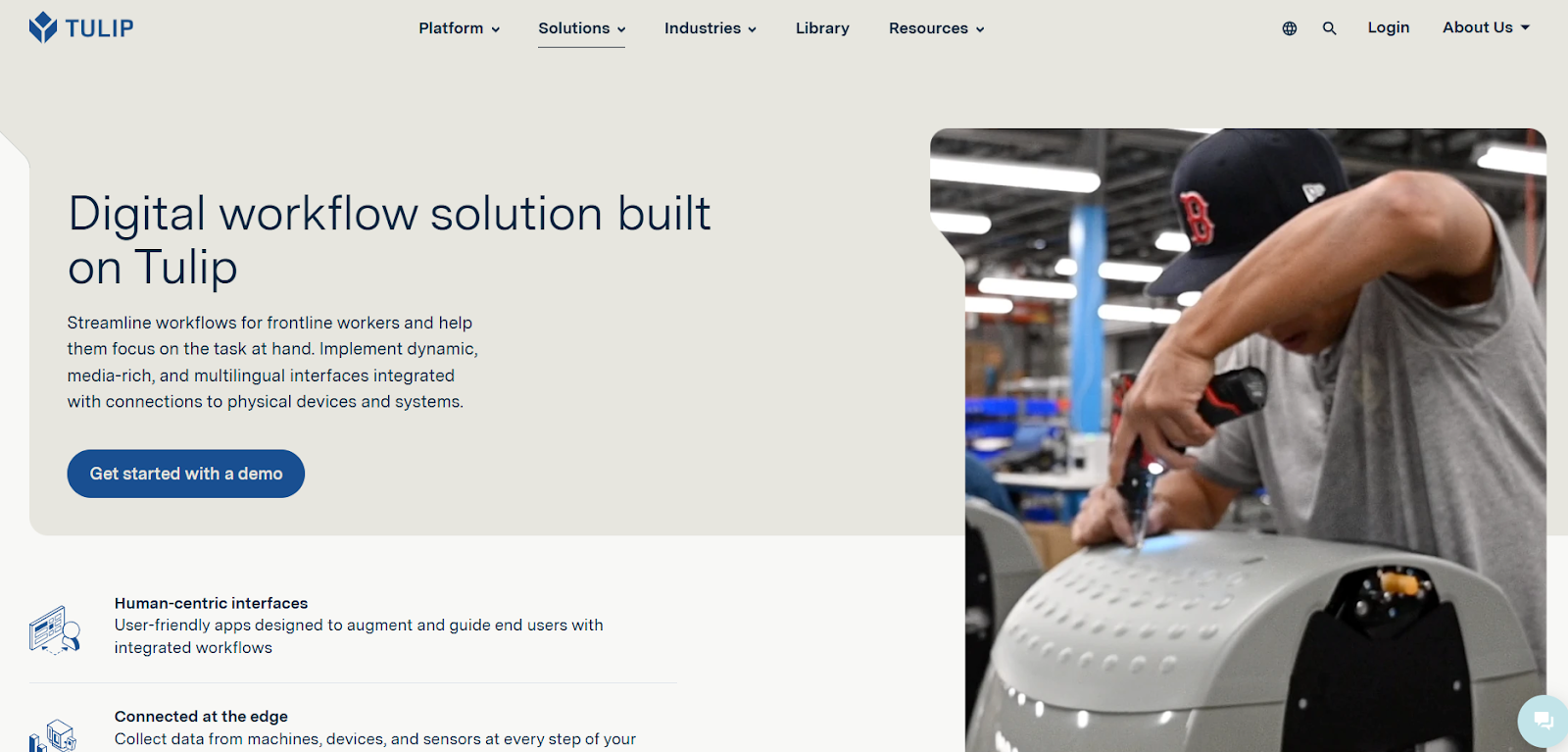
Type: No-code manufacturing operations platform
Best for: Manufacturing, assembly, and production environments
Tulip specializes in creating digital work instructions and connected factory applications without requiring coding expertise. The platform excels in manufacturing environments where real-time data collection and process standardization are essential.
Key Features:
- Drag-and-drop app builder for custom manufacturing workflows
- Interactive digital work instructions with visual guides
- Real-time machine connectivity and IoT sensor integration
- Quality control checkpoints and automated data capture
- Advanced analytics dashboard with production insights
Pros: Intuitive visual interface enables rapid application development. Strong integration capabilities with existing manufacturing systems.
Cons: Requires initial setup time and operator training for optimal adoption.
Ideal Use Case: Manufacturing companies seeking to digitize production processes and eliminate paper-based work instructions while maintaining quality standards.
3. Augmentir
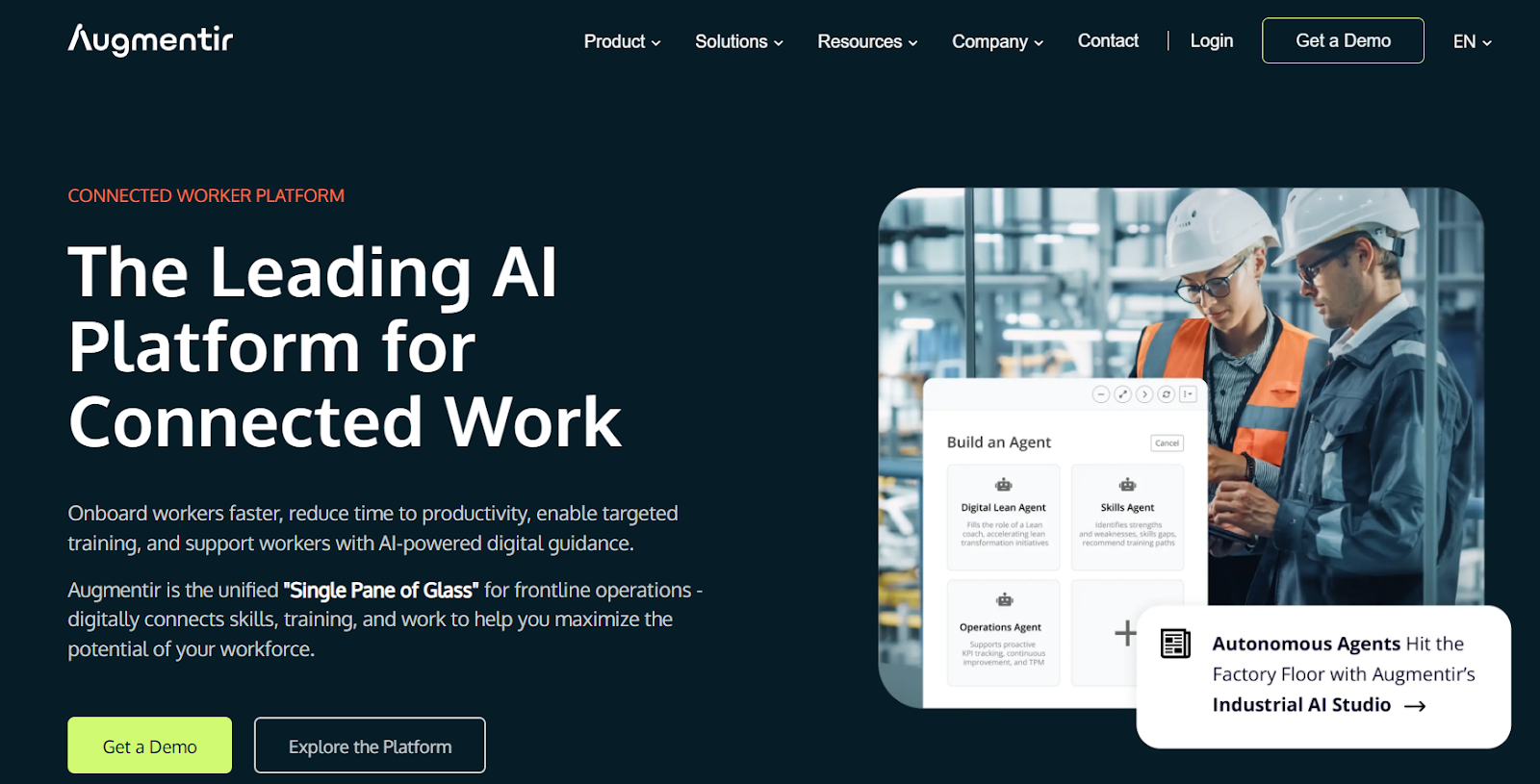
Type: AI-driven connected worker platform
Best for: Manufacturing and field service operations
Augmentir combines artificial intelligence with workforce management to optimize worker performance. The platform provides thoughtful guidance and predictive insights for long-term operational improvement.
Key Features:
- AI-powered competent guidance and decision support
- Comprehensive skill mapping and competency tracking
- Remote expert support and collaboration tools
- Advanced workforce analytics and performance insights
- Predictive maintenance and operational optimization
Pros: Excellent analytics capabilities and workforce development features. Strong focus on continuous improvement and skill building.
Cons: Best suited for technology-ready organizations with dedicated IT resources.
Ideal Use Case: Companies investing in long-term workforce optimization and predictive operational strategies.
4. TELUS Connected Worker Solutions
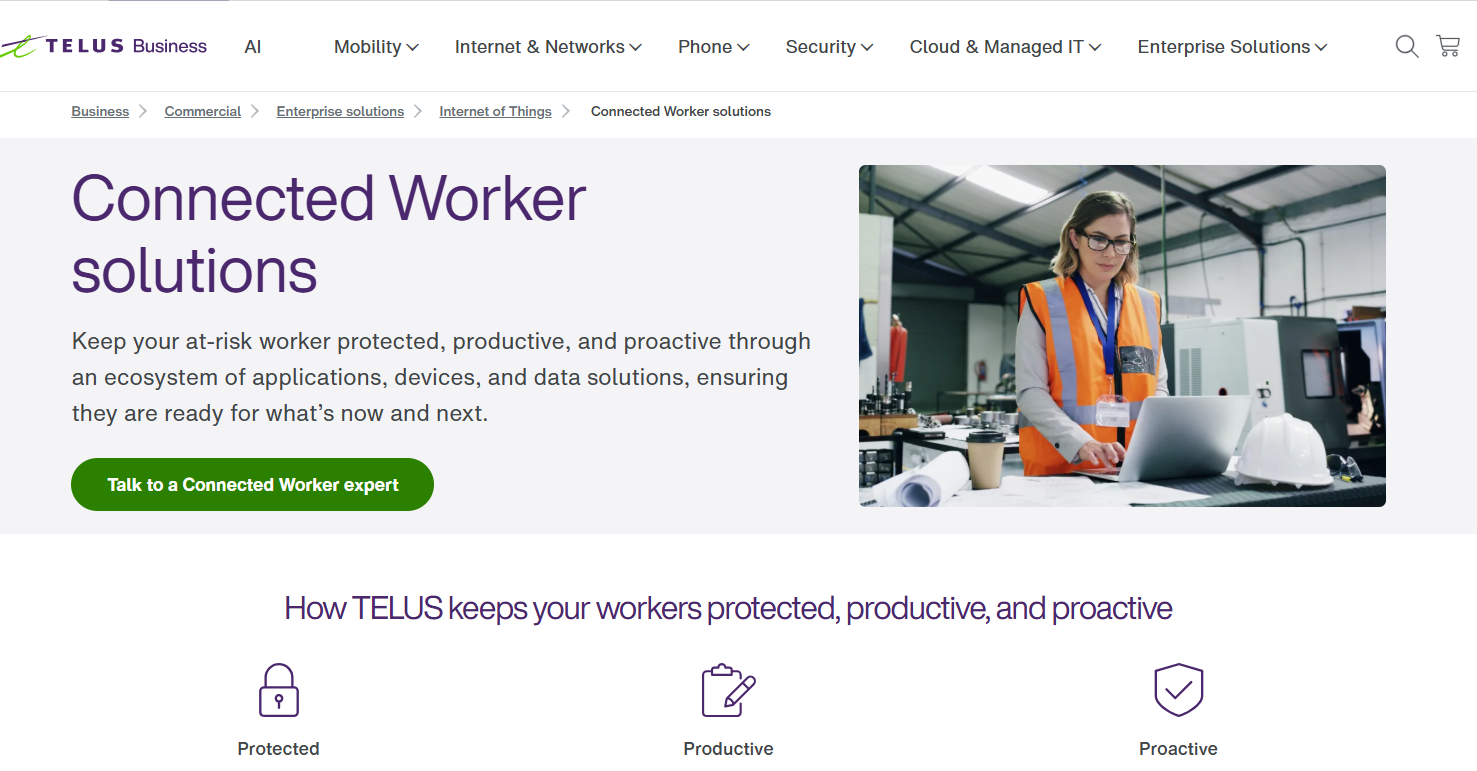
Type: IoT and workforce safety ecosystem
Best for: Utilities, construction, and telecommunications
TELUS combines Internet of Things technology with worker safety monitoring. The platform excels in hazardous environments where worker safety is the primary concern.
Key Features:
- Wearable device integration for health monitoring
- Lone worker monitoring with automatic check-ins
- Panic button functionality and emergency response
- Geofencing capabilities for location-based alerts
- Environmental sensor integration for hazard detection
Pros: Powerful safety features for high-risk work environments. Comprehensive monitoring and emergency response capabilities.
Cons: Higher upfront investment requirements and hardware dependency issues.
Ideal Use Case: Enhancing worker safety and visibility in hazardous or remote work environments.
5. Workerbase
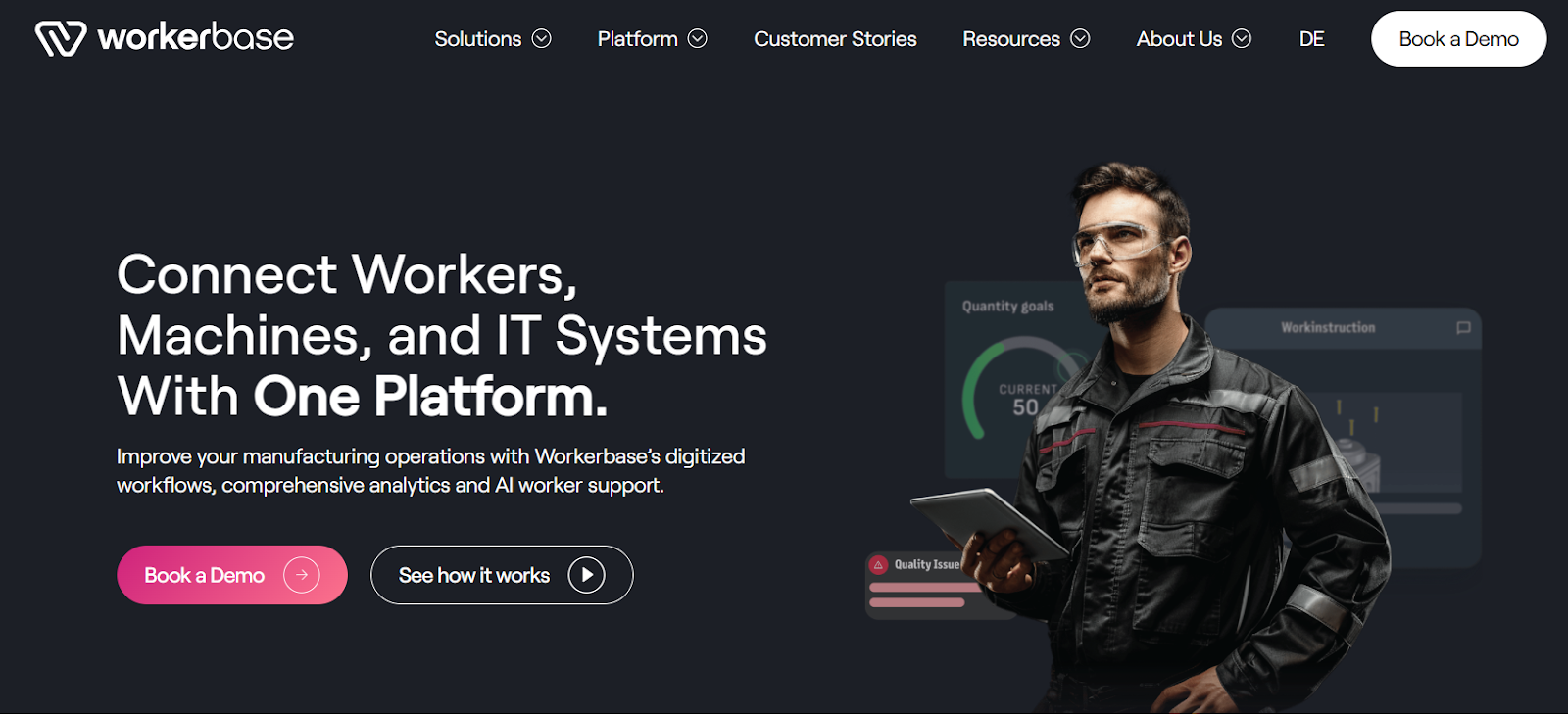
Type: Modular platform for digital manufacturing
Best for: Automotive, electronics, and discrete manufacturing
Workerbase specializes in manufacturing floor optimization through connected worker technology. The platform integrates deeply with manufacturing systems and IoT devices.
Key Features:
- Mobile workflow management for shop floor operations
- Real-time task assignment and progress tracking
- Machine connectivity and data integration
- Worker assistance applications with guided procedures
- Production analytics and performance monitoring
Pros: Highly customizable platform with strong shop floor integration capabilities.
Cons: Limited applicability outside manufacturing environments.
Ideal Use Case: Manufacturing facilities seeking to optimize production floors with IoT-connected worker solutions.
6. Poka
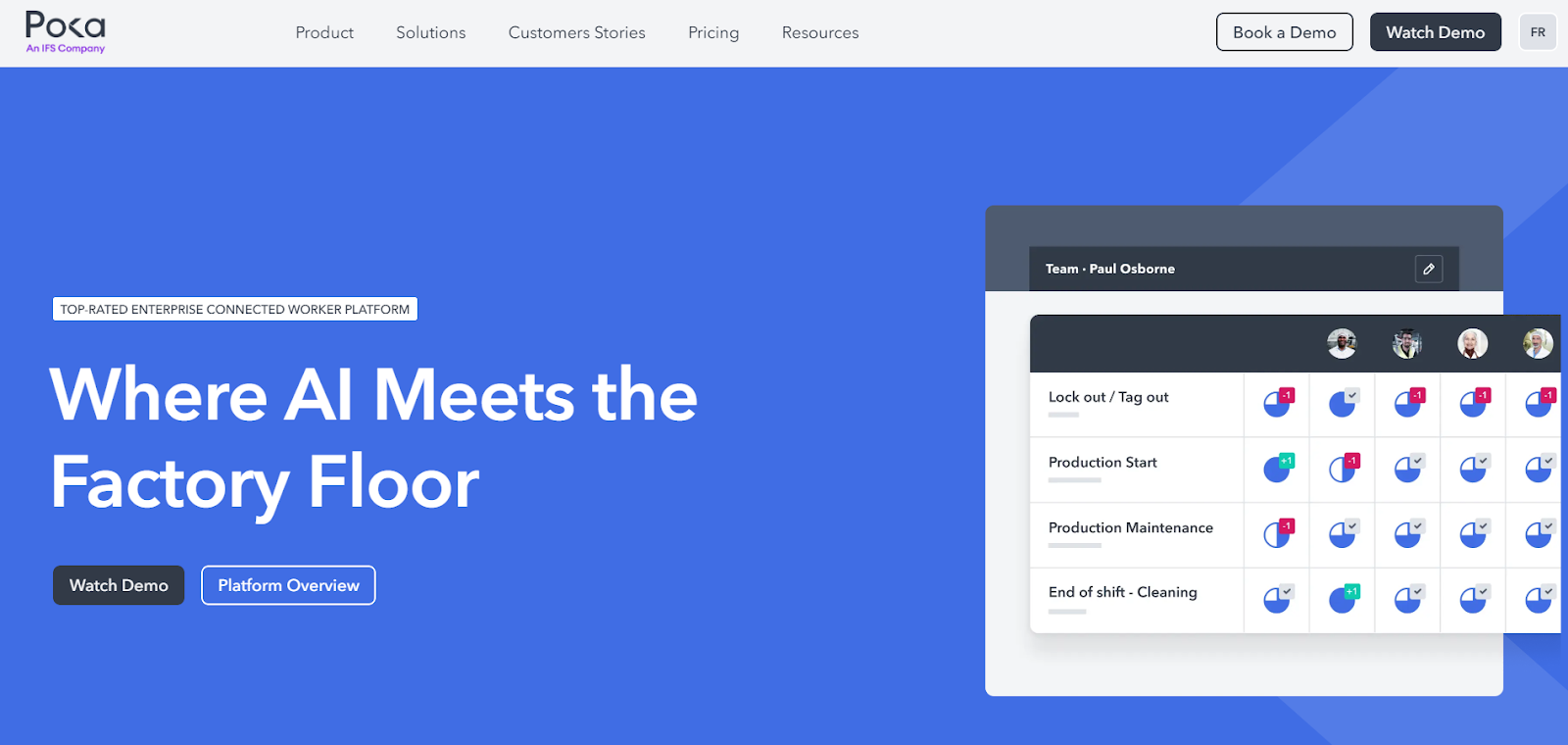
Type: Connected worker platform focused on knowledge sharing
Best for: Food and beverage, consumer packaged goods, pharmaceutical
Poka emphasizes training and knowledge retention through video-based learning systems. The platform helps standardize procedures across multiple locations.
Key Features:
- Video-based training content creation and delivery
- Collaborative tools for knowledge sharing
- Performance analytics and skill assessment
- Digital procedure documentation and updates
- Multi-location standardization capabilities
Pros: Strong learning and development features with comprehensive training tools.
Cons: Limited real-time communication and emergency alert capabilities.
Ideal Use Case: Manufacturers seeking standardized training programs and improved knowledge retention across locations.
7. MaintainX
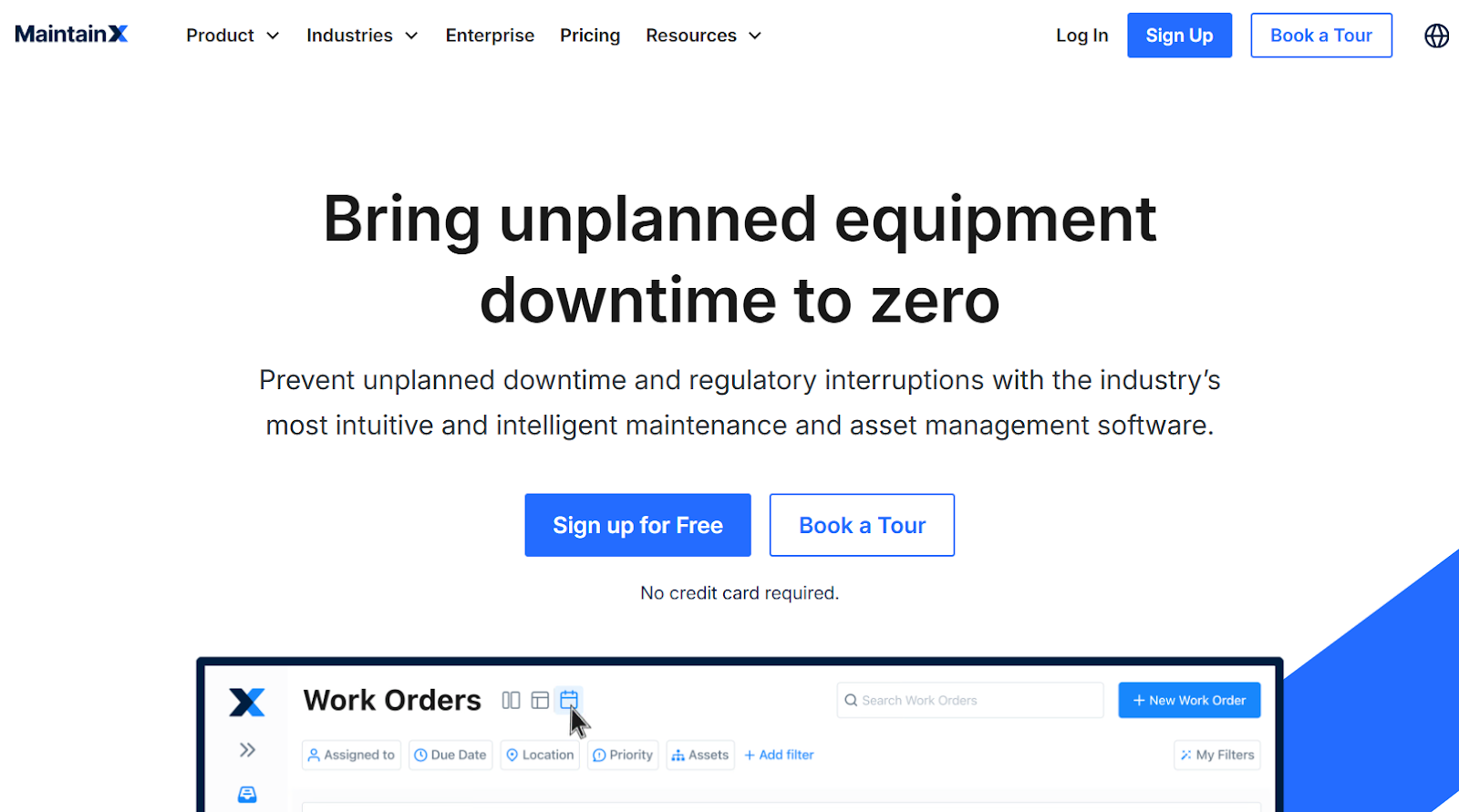
Type: Mobile CMMS and digital work order platform
Best for: Facilities management, maintenance teams, manufacturing
MaintainX simplifies maintenance operations through a mobile-first design. The platform focuses on work order management and asset tracking capabilities.
Key Features:
- Comprehensive work order management system
- Asset tracking and maintenance scheduling
- Mobile checklist completion and verification
- Inventory management and parts tracking
- Maintenance analytics and reporting tools
Pros: Simple user interface design enables fast deployment and adoption.
Cons: More operations-focused than a communication-centered platform.
Ideal Use Case: Companies managing large-scale maintenance operations with mobile workforce teams.
Platform Comparison Overview Table
Understanding these key differences helps you identify which connected worker platform aligns with your specific operational needs.
How to Choose the Right Platform for Your Frontline Teams
Selecting the right connected worker platform requires careful consideration of your workforce characteristics and operational requirements. Start by evaluating your team's technology comfort level and current communication methods.
- Device Compatibility Assessment: Determine whether your workers use smartphones consistently or rely on basic phones. Some platforms require specific hardware, while others work with any device. SMS-based solutions like Udext accommodate all device types without additional hardware costs.
- Communication Urgency Requirements: Assess how quickly critical information must reach your team. Real-time safety alerts and emergency communications require instant delivery systems. Consider whether your operations can tolerate delays or require immediate acknowledgment.
- Feature Priority Analysis: Identify whether you need comprehensive training content, safety monitoring capabilities, or streamlined task management. Some platforms excel in specific areas while others provide broader functionality.
- Implementation Timeline Constraints: Evaluate how quickly you need the platform operational. Emergency deployments require solutions with minimal setup time and training requirements. Long-term implementations allow for more complex systems with extensive customization.
- Budget and IT Resource Evaluation: Consider upfront costs and ongoing maintenance requirements. Factor in hardware needs, training costs, and internal IT support capacity. Some platforms require dedicated technical resources while others operate independently.
These considerations guide you toward the platform that best matches your organization's unique requirements and constraints.
Why Udext Leads on Adoption
Udext stands out as the most adoptable connected worker platform by tackling one of the biggest challenges on the frontline: communication fatigue from app overload. Most tools force workers to download apps, manage logins, and learn new interfaces, creating barriers to adoption and slowing productivity. Udext removes these obstacles with a 100% SMS-native approach requiring no apps, data, or learning curve.
Key reasons Udext leads in adoption:
- No apps or logins required: Works instantly on any phone, including basic feature phones
- High message visibility: Leverages SMS with over 98% open rate for urgent and routine updates
- Instant onboarding: New hires can receive and respond to messages on day one, with no setup
- Supports all worker types: Effective for full-time, part-time, seasonal, and contract workers
- Multilingual messaging: Communicate clearly across diverse teams in their preferred language
- Automated workflows: Schedule, segment, and send messages tied to shifts, compliance, or HR events
- Seamless integrations: Connects easily to HRIS and scheduling platforms for real-time sync
- Built for low-tech environments: No Wi-Fi or app store access needed; reliable even in remote job sites
Whether your teams are in logistics, construction, manufacturing, or healthcare, Udext ensures universal accessibility and immediate engagement, helping you reach your workforce where they are, how they work, and in the language they understand. Book a Demo Today →
Conclusion
The right connected worker platform transforms frontline operations by bridging communication gaps and improving operational efficiency. Each platform offers unique strengths suited to different industries and organizational needs.
SMS-first solutions like Udext provide immediate value through universal accessibility and zero learning curves. Complex AI-driven platforms offer long-term optimization benefits for technology-ready organizations. Safety-focused systems protect workers in hazardous environments while manufacturing-specific platforms optimize production workflows.
Your choice depends on workforce characteristics, operational requirements, and implementation constraints. When selecting, consider device compatibility, communication urgency, feature priorities, and budget limitations.
The frontline workforce drives business success. Investing in the right connected worker platform ensures your team has the tools to excel in the prevailing business environment.
Ready to see how SMS-native communication can transform your frontline operations? Discover how Udext connects your team instantly without apps or complexity.
Need to improve your internal comms? Take a look at Udext!
"Out of the box, Udext has everything you need to elevate your internal communication. It’s incredibly easy to set up and use, with a straightforward interface and great customer support"
John D.
Director of HR at Apex Manufacturing


.svg)


.jpeg)
.jpeg)


